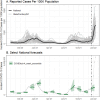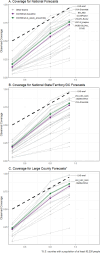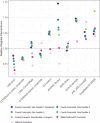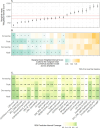Challenges of COVID-19 Case Forecasting in the US, 2020-2021
- PMID: 38709852
- PMCID: PMC11098513
- DOI: 10.1371/journal.pcbi.1011200
Challenges of COVID-19 Case Forecasting in the US, 2020-2021
Abstract
During the COVID-19 pandemic, forecasting COVID-19 trends to support planning and response was a priority for scientists and decision makers alike. In the United States, COVID-19 forecasting was coordinated by a large group of universities, companies, and government entities led by the Centers for Disease Control and Prevention and the US COVID-19 Forecast Hub (https://covid19forecasthub.org). We evaluated approximately 9.7 million forecasts of weekly state-level COVID-19 cases for predictions 1-4 weeks into the future submitted by 24 teams from August 2020 to December 2021. We assessed coverage of central prediction intervals and weighted interval scores (WIS), adjusting for missing forecasts relative to a baseline forecast, and used a Gaussian generalized estimating equation (GEE) model to evaluate differences in skill across epidemic phases that were defined by the effective reproduction number. Overall, we found high variation in skill across individual models, with ensemble-based forecasts outperforming other approaches. Forecast skill relative to the baseline was generally higher for larger jurisdictions (e.g., states compared to counties). Over time, forecasts generally performed worst in periods of rapid changes in reported cases (either in increasing or decreasing epidemic phases) with 95% prediction interval coverage dropping below 50% during the growth phases of the winter 2020, Delta, and Omicron waves. Ideally, case forecasts could serve as a leading indicator of changes in transmission dynamics. However, while most COVID-19 case forecasts outperformed a naïve baseline model, even the most accurate case forecasts were unreliable in key phases. Further research could improve forecasts of leading indicators, like COVID-19 cases, by leveraging additional real-time data, addressing performance across phases, improving the characterization of forecast confidence, and ensuring that forecasts were coherent across spatial scales. In the meantime, it is critical for forecast users to appreciate current limitations and use a broad set of indicators to inform pandemic-related decision making.
Copyright: This is an open access article, free of all copyright, and may be freely reproduced, distributed, transmitted, modified, built upon, or otherwise used by anyone for any lawful purpose. The work is made available under the Creative Commons CC0 public domain dedication.
Conflict of interest statement
I have read the journal’s policy and the authors of this manuscript have the following competing interests: APP report grants from Metabiota Inc outside the submitted work. J.S. and Columbia University declare partial ownership of SK Analytics. No other authors have competing interests to declare.
Figures








References
-
- Holcomb KM, Barker CM, Keyel Wadsworth Center Matteo Marcantonio AC, Childs ML, Gorris ME, Hamins-Puértolas M, et al.. Evaluation of an open forecasting challenge to assess skill of West Nile virus neuroinvasive disease prediction. 2022. Aug 26 [cited 2022 Dec 16]; Available from: https://www.researchsquare.com. - PMC - PubMed

